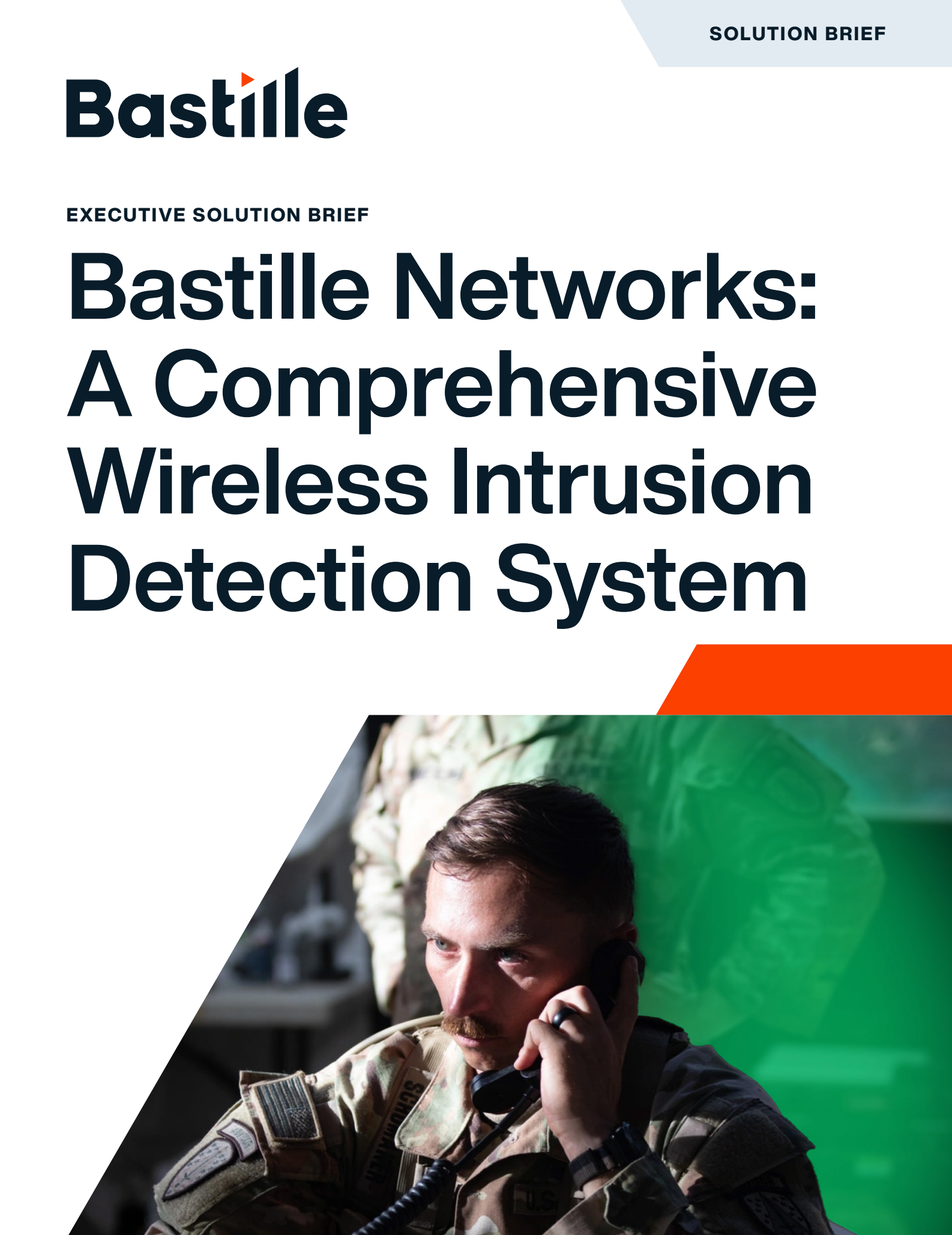
Traditional cybersecurity defenses focus on wired and Wi-Fi networks – but attackers are increasingly using wireless devices and RF signals to bypass these controls. To close this gap, enterprises are turning to Wireless Intrusion Detection Systems (WIDS).
WIDS continuously monitors the airspace for rogue devices, unauthorized access points, and suspicious transmissions – threats that traditional firewalls and intrusion detection systems (IDS) cannot see.
This article explains what WIDS is, how it works, its limitations, and why Bastille delivers the next generation of wireless threat detection.
What is a Wireless Intrusion Detection System (WIDS)?
A Wireless Intrusion Detection System (WIDS) is a specialized security solution designed to monitor wireless network activity and detect threats in real time. Unlike traditional Intrusion Detection Systems (IDS) that focus primarily on wired network traffic, WIDS provides visibility into the wireless layer — an area that is often overlooked but highly vulnerable to attacks.
WIDS continuously scans the airspace around your network to identify and alert you to:
- Unauthorized Access Points – Detecting rogue or “evil twin” access points that could trick users into connecting.
- Rogue or Unauthorized Devices – Spotting unknown devices trying to join the network.
- Suspicious Behavior – Identifying abnormal traffic patterns or attempts to exploit wireless protocols.
- Policy Violations – Ensuring employees connect only to approved SSIDs and use secure configurations.
By providing early detection of wireless threats, WIDS helps prevent attackers from using Wi-Fi networks as a backdoor into your organization. This allows security teams to take immediate action, block malicious devices, and maintain compliance with security frameworks such as PCI DSS, HIPAA, or ISO 27001.
How WIDS Works
WIDS systems typically:
- Continuous Monitoring of RF & Wi-Fi: Sensors track all nearby wireless activity, building a baseline of “normal” behavior.
- Detection of Rogue Access Points: If a new or unauthorized Wi-Fi access point appears, WIDS can alert security teams.
- Rogue Device Detection & Alerts: Unapproved laptops, smartphones, or IoT devices attempting to connect are flagged as potential threats.
Why Organizations Need WIDS
Enterprises face growing threats from unmanaged and hidden wireless devices:
- Insider Threats: Employees, contractors, or visitors may bring in personal devices that create unauthorized wireless channels.
- Data Exfiltration via Rogue Devices: Attackers can smuggle out sensitive data over Wi-Fi or cellular without ever touching the wired network.
- Compliance Requirements: Regulations such as HIPAA, PCI DSS, and NIST require organizations to monitor and secure all devices handling sensitive data — including wireless ones.
Limitations of Traditional WIDS
Most legacy WIDS solutions focus only on Wi-Fi networks, leaving major blind spots:
- No visibility into cellular, Bluetooth, or IoT devices.
- Inability to detect RF-enabled insider threats.
- Limited ability to physically locate rogue devices within a building.
This Wi-Fi-only approach is no longer enough in today’s multi-radio environments.
Bastille’s Advanced WIDS Solution
Bastille extends WIDS beyond Wi-Fi to cover the entire RF spectrum. With Bastille, enterprises gain:
- Full RF visibility: Detect devices using Wi-Fi, Bluetooth, ZigBee, LoRa, cellular, and other wireless protocols.
- Location tracking: Pinpoint exactly where rogue devices are operating inside facilities.
- Insider threat detection: Identify unauthorized or hidden devices brought in by staff, contractors, or visitors.
- Compliance support: Maintain HIPAA, PCI DSS, and other regulatory compliance with continuous monitoring and reporting.
Bastille transforms WIDS into a next-generation wireless security platform.
Next Steps for Enterprises
Protecting your organization from wireless and RF-enabled threats requires a proactive, layered approach. Here’s what security-conscious enterprises should do next:
- Conduct a Wireless Vulnerability & Threat Assessment
Start by mapping your wireless environment and identifying hidden risks such as rogue access points, unauthorized devices, and insecure configurations. This establishes a baseline for improvement. - Deploy Continuous RF Monitoring
Implement a Wireless Intrusion Detection System (WIDS) to continuously monitor for suspicious activity across all critical facilities, branch offices, and remote sites. - Enforce Strong Policies & Controls
Develop and enforce policies governing the use of mobile devices, IoT endpoints, and guest Wi-Fi access. Ensure only authorized devices connect, and regularly review compliance with security standards. - Integrate Wireless Security into Incident Response
Make sure wireless threat alerts feed directly into your SIEM or SOC workflows, enabling faster detection, investigation, and response. - Train Staff & Raise Awareness
Educate employees and IT teams on common wireless attack methods, including rogue APs, spoofing, and jamming, so they can recognize and report anomalies.
Conclusion
As attackers shift to exploiting wireless blind spots, enterprises can no longer rely on traditional firewalls and Wi-Fi-only monitoring. A Wireless Intrusion Detection System (WIDS) is essential for defending against rogue devices, insider threats, and compliance violations.
Request a demo of Bastille’s advanced WIDS solution to gain full-spectrum visibility into your wireless environment.




